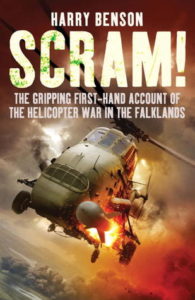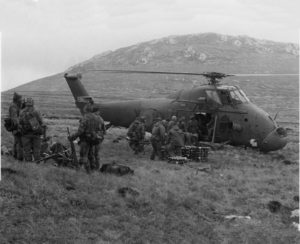Podcast: Play in new window | Download
Subscribe: RSS

6834 nautical miles south west of London in the South Atlantic some amazing helicopter stories were being lived out during the Falklands War. Many of these were even unknown to the other aircrew flying in the same operational area.
Harry Benson was there as a 21 yr old pilot and many years later has interviewed 45 of his fellow aircrew and pieced together the story of the helicopter side of that conflict. You can read the result in the book Scram!: The Gripping First-Hand Account of the Helicopter War in the Falklands.
Scram was the radio codeword for inbound Argentine jets and the ‘actions on’ for helicopter crews was to find a depression and land the helicopter as quickly as they could to minimise the chance of being sighted.
 Logistically getting the UK forces down to the Falklands was an amazing feat as everything had to go by sea or be dropped into the ocean from the air. Helicopters were crammed onto vessels wherever they could fit. A requisitioned Cunard container ship ‘Atlantic Conveyor’ carried a cargo of six Wessex helicopters from 848 Naval Air Squadron and RAF Chinook HC.1s from No. 18 Squadron RAF. At Ascension Island, the halfway point, she picked up eight Fleet Air Arm Sea Harriers (809 Squadron) and six RAF Harrier GR.3 jump jets.
Logistically getting the UK forces down to the Falklands was an amazing feat as everything had to go by sea or be dropped into the ocean from the air. Helicopters were crammed onto vessels wherever they could fit. A requisitioned Cunard container ship ‘Atlantic Conveyor’ carried a cargo of six Wessex helicopters from 848 Naval Air Squadron and RAF Chinook HC.1s from No. 18 Squadron RAF. At Ascension Island, the halfway point, she picked up eight Fleet Air Arm Sea Harriers (809 Squadron) and six RAF Harrier GR.3 jump jets.

The harsh South Atlantic weather proved one of the biggest challenges for aircrew rather than enemy action. Harry tells the story of his port engine shutting down due to heavy snow blocking the intake. At times aircraft had to hover taxi next to cliffs above the waves due to poor visibility in fog.

Just some of the stories in the book:
-
- Going head to head with fast jets
- Sneak single aircraft mission with missile strike on Argentine high command
- Rescues of sailors off burning ships
- One way Seaking flight to Argentina mainland to assault airbase
- Radalts going from 30′ to 200′ flying over glaciers
- SAS missions in 60kt winds
- Getting low on fuel and shutting down one engine
- Night unaided casualty evacuations from front line
Podcast: Subscribe in iTunes | Play in new window | Download
Links from this week’s episode:
Support the podcast on Patreon
World Helicopter Day – Register Your Event
Scram!: The Gripping First-Hand Account of the Helicopter War in the Falklands
Junglie – Seaking pilot fiction novel by Harry Benson
Special Forces Pilot: A Flying Memoir of the Falkland War – Story of the Seaking raid on Argentina
Historic Helicopters – UK helicopter event

Be part of the conversation by leaving a comment below.

